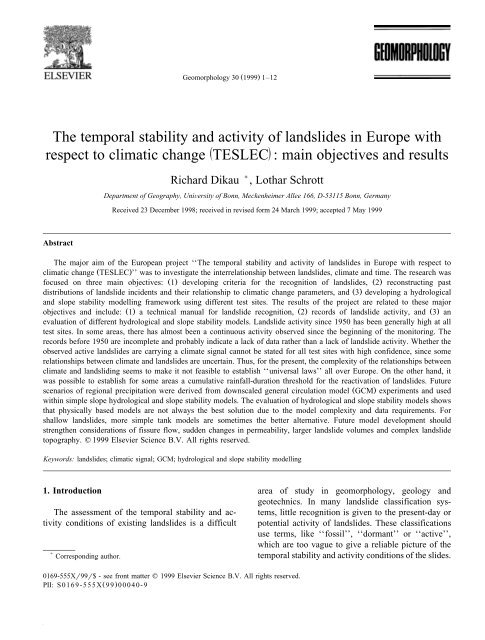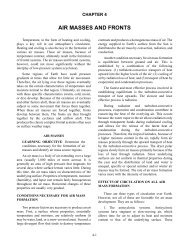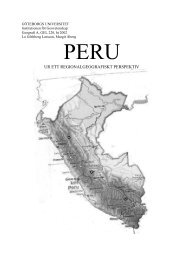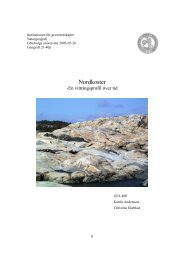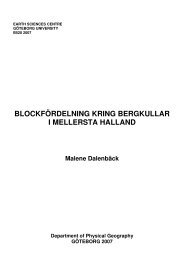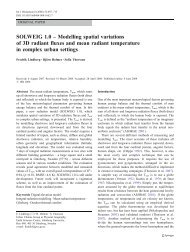The temporal stability and activity of landslides in Europe with ž ...
The temporal stability and activity of landslides in Europe with ž ...
The temporal stability and activity of landslides in Europe with ž ...
You also want an ePaper? Increase the reach of your titles
YUMPU automatically turns print PDFs into web optimized ePapers that Google loves.
Ž .<br />
Geomorphology 30 1999 1–12<br />
<strong>The</strong> <strong>temporal</strong> <strong>stability</strong> <strong>and</strong> <strong>activity</strong> <strong>of</strong> l<strong>and</strong>slides <strong>in</strong> <strong>Europe</strong> <strong>with</strong><br />
<strong>ž</strong> /<br />
respect to climatic change TESLEC : ma<strong>in</strong> objectives <strong>and</strong> results<br />
Abstract<br />
Richard Dikau ) , Lothar Schrott<br />
Department <strong>of</strong> Geography, UniÕersity <strong>of</strong> Bonn, Meckenheimer Allee 166, D-53115 Bonn, Germany<br />
Received 23 December 1998; received <strong>in</strong> revised form 24 March 1999; accepted 7 May 1999<br />
<strong>The</strong> major aim <strong>of</strong> the <strong>Europe</strong>an project ‘‘<strong>The</strong> <strong>temporal</strong> <strong>stability</strong> <strong>and</strong> <strong>activity</strong> <strong>of</strong> l<strong>and</strong>slides <strong>in</strong> <strong>Europe</strong> <strong>with</strong> respect to<br />
climatic change Ž TESLEC . ’’ was to <strong>in</strong>vestigate the <strong>in</strong>terrelationship between l<strong>and</strong>slides, climate <strong>and</strong> time. <strong>The</strong> research was<br />
focused on three ma<strong>in</strong> objectives: Ž. 1 develop<strong>in</strong>g criteria for the recognition <strong>of</strong> l<strong>and</strong>slides, Ž. 2 reconstruct<strong>in</strong>g past<br />
distributions <strong>of</strong> l<strong>and</strong>slide <strong>in</strong>cidents <strong>and</strong> their relationship to climatic change parameters, <strong>and</strong> Ž. 3 develop<strong>in</strong>g a hydrological<br />
<strong>and</strong> slope <strong>stability</strong> modell<strong>in</strong>g framework us<strong>in</strong>g different test sites. <strong>The</strong> results <strong>of</strong> the project are related to these major<br />
objectives <strong>and</strong> <strong>in</strong>clude: Ž. 1 a technical manual for l<strong>and</strong>slide recognition, Ž. 2 records <strong>of</strong> l<strong>and</strong>slide <strong>activity</strong>, <strong>and</strong> Ž. 3 an<br />
evaluation <strong>of</strong> different hydrological <strong>and</strong> slope <strong>stability</strong> models. L<strong>and</strong>slide <strong>activity</strong> s<strong>in</strong>ce 1950 has been generally high at all<br />
test sites. In some areas, there has almost been a cont<strong>in</strong>uous <strong>activity</strong> observed s<strong>in</strong>ce the beg<strong>in</strong>n<strong>in</strong>g <strong>of</strong> the monitor<strong>in</strong>g. <strong>The</strong><br />
records before 1950 are <strong>in</strong>complete <strong>and</strong> probably <strong>in</strong>dicate a lack <strong>of</strong> data rather than a lack <strong>of</strong> l<strong>and</strong>slide <strong>activity</strong>. Whether the<br />
observed active l<strong>and</strong>slides are carry<strong>in</strong>g a climate signal cannot be stated for all test sites <strong>with</strong> high confidence, s<strong>in</strong>ce some<br />
relationships between climate <strong>and</strong> l<strong>and</strong>slides are uncerta<strong>in</strong>. Thus, for the present, the complexity <strong>of</strong> the relationships between<br />
climate <strong>and</strong> l<strong>and</strong>slid<strong>in</strong>g seems to make it not feasible to establish ‘‘universal laws’’ all over <strong>Europe</strong>. On the other h<strong>and</strong>, it<br />
was possible to establish for some areas a cumulative ra<strong>in</strong>fall-duration threshold for the reactivation <strong>of</strong> l<strong>and</strong>slides. Future<br />
scenarios <strong>of</strong> regional precipitation were derived from downscaled general circulation model Ž GCM. experiments <strong>and</strong> used<br />
<strong>with</strong><strong>in</strong> simple slope hydrological <strong>and</strong> slope <strong>stability</strong> models. <strong>The</strong> evaluation <strong>of</strong> hydrological <strong>and</strong> slope <strong>stability</strong> models shows<br />
that physically based models are not always the best solution due to the model complexity <strong>and</strong> data requirements. For<br />
shallow l<strong>and</strong>slides, more simple tank models are sometimes the better alternative. Future model development should<br />
strengthen considerations <strong>of</strong> fissure flow, sudden changes <strong>in</strong> permeability, larger l<strong>and</strong>slide volumes <strong>and</strong> complex l<strong>and</strong>slide<br />
topography. q 1999 Elsevier Science B.V. All rights reserved.<br />
Keywords: l<strong>and</strong>slides; climatic signal; GCM; hydrological <strong>and</strong> slope <strong>stability</strong> modell<strong>in</strong>g<br />
1. Introduction<br />
<strong>The</strong> assessment <strong>of</strong> the <strong>temporal</strong> <strong>stability</strong> <strong>and</strong> <strong>activity</strong><br />
conditions <strong>of</strong> exist<strong>in</strong>g l<strong>and</strong>slides is a difficult<br />
) Correspond<strong>in</strong>g author.<br />
0169-555Xr99r$ - see front matter q 1999 Elsevier Science B.V. All rights reserved.<br />
Ž .<br />
PII: S0169-555X 99 00040-9<br />
area <strong>of</strong> study <strong>in</strong> geomorphology, geology <strong>and</strong><br />
geotechnics. In many l<strong>and</strong>slide classification systems,<br />
little recognition is given to the present-day or<br />
potential <strong>activity</strong> <strong>of</strong> l<strong>and</strong>slides. <strong>The</strong>se classifications<br />
use terms, like ‘‘fossil’’, ‘‘dormant’’ or ‘‘active’’,<br />
which are too vague to give a reliable picture <strong>of</strong> the<br />
<strong>temporal</strong> <strong>stability</strong> <strong>and</strong> <strong>activity</strong> conditions <strong>of</strong> the slides.
2<br />
Moreover, they do not give the quantitative characteristics<br />
<strong>and</strong> physical background <strong>of</strong> the <strong>temporal</strong><br />
mov<strong>in</strong>g pattern <strong>in</strong> the past nor they reliably <strong>in</strong>dicate<br />
future patterns <strong>of</strong> <strong>activity</strong>. Methods are available to<br />
dist<strong>in</strong>guish between active <strong>and</strong> <strong>in</strong>active l<strong>and</strong>slides,<br />
but a larger number <strong>of</strong> mutually supportive <strong>and</strong><br />
complementary methods are required to assess the<br />
past, present <strong>and</strong> possible future patterns <strong>of</strong> behaviour.<br />
A detailed diagnosis for <strong>activity</strong> requires<br />
more detailed geological–stratigraphical data <strong>and</strong><br />
field observations <strong>and</strong> especially more elaborate<br />
methods <strong>of</strong> modell<strong>in</strong>g <strong>and</strong> analysis. Earth sciences,<br />
hydrological sciences <strong>and</strong> geotechnics have methods<br />
<strong>and</strong> models suitable to carry out these tasks.<br />
One major task <strong>of</strong> the <strong>temporal</strong> <strong>stability</strong> <strong>and</strong><br />
<strong>activity</strong> <strong>of</strong> l<strong>and</strong>slides <strong>in</strong> <strong>Europe</strong> <strong>with</strong> respect to climatic<br />
change Ž TESLEC. project was to comb<strong>in</strong>e the<br />
resources <strong>of</strong> these discipl<strong>in</strong>es by focus<strong>in</strong>g them on<br />
the solution to this problem. A further task <strong>of</strong> the<br />
TESLEC project was the identification <strong>of</strong> the <strong>temporal</strong><br />
<strong>stability</strong> condition <strong>of</strong> l<strong>and</strong>slides which serves as a<br />
necessary calibration to assess the future slide behaviour<br />
under a changed climate. <strong>The</strong> results are<br />
supposed to improve the predictability <strong>of</strong> future<br />
l<strong>and</strong>slide activities by means <strong>of</strong> a better underst<strong>and</strong><strong>in</strong>g,<br />
firstly, <strong>of</strong> the climatically caused fluctuations <strong>in</strong><br />
slope <strong>stability</strong> <strong>and</strong>, secondly, <strong>of</strong> the dom<strong>in</strong>ant parameters<br />
which control the <strong>activity</strong> <strong>of</strong> l<strong>and</strong>slides.<br />
<strong>The</strong> purpose <strong>of</strong> this paper is to summarise the<br />
objectives, methodologies <strong>and</strong> achievements <strong>of</strong> the<br />
TESLEC project. It will identify the constra<strong>in</strong>ts <strong>and</strong><br />
opportunities that have arisen <strong>in</strong> the course <strong>of</strong> the<br />
research. In addition, the value <strong>of</strong> the results will be<br />
discussed <strong>and</strong> directions for further research will be<br />
identified. Different l<strong>and</strong>slide test sites <strong>in</strong> <strong>Europe</strong><br />
have been selected <strong>in</strong> order to achieve the aims <strong>of</strong><br />
the project. <strong>The</strong> ma<strong>in</strong> criteria for the selection <strong>of</strong> the<br />
test sites were related to: Ž. 1 the existence <strong>of</strong> ongo<strong>in</strong>g<br />
research <strong>with</strong> l<strong>and</strong>slide monitor<strong>in</strong>g <strong>and</strong>ror historical<br />
data, Ž. 2 site specific hazard potential, Ž. 3<br />
high recent l<strong>and</strong>slide <strong>activity</strong>, <strong>and</strong> Ž. 4 the requirement<br />
that different l<strong>and</strong>slide types be <strong>in</strong>cluded. Thus,<br />
research was focused on site specific scales, which<br />
means that the representativeness <strong>of</strong> each particular<br />
site was not the major objective <strong>of</strong> site selection.<br />
Depend<strong>in</strong>g on the test site, the <strong>temporal</strong> scale <strong>of</strong> the<br />
research covered a wide range <strong>in</strong>clud<strong>in</strong>g historical<br />
events as well as present <strong>activity</strong>.<br />
( )<br />
R. Dikau, L. SchrottrGeomorphology 30 1999 1–12<br />
Key questions related to climatic signals <strong>in</strong> l<strong>and</strong>slide<br />
processes were discussed on the <strong>Europe</strong>an Science<br />
Foundation workshop ‘‘Rapid mass movement<br />
<strong>and</strong> climatic variation dur<strong>in</strong>g the Holocene’’ at the<br />
Academy <strong>of</strong> Sciences, Ma<strong>in</strong>z, Germany <strong>in</strong> 1993<br />
Ž Matthews et al., 1997 . . <strong>The</strong> discussion was focused<br />
on the climatic controls on rapid mass movements<br />
dur<strong>in</strong>g the Holocene. <strong>The</strong> general conclusions show<br />
that despite many l<strong>and</strong>slide data sets available, too<br />
few high quality records are able to give a cont<strong>in</strong>uous<br />
picture even <strong>of</strong> s<strong>in</strong>gle sites. It has been further<br />
shown that while the data records conta<strong>in</strong> a climatic<br />
signal, non-climatic factors Žgeology,<br />
geomorphology,<br />
human impact. significantly <strong>in</strong>fluence the climatic<br />
signal. It was stated that more work has to be<br />
done <strong>in</strong> correlat<strong>in</strong>g precipitation proxy data <strong>with</strong><br />
rapid mass movement records <strong>in</strong>clud<strong>in</strong>g ra<strong>in</strong>fall<br />
threshold models for regions <strong>with</strong> similar climate. A<br />
further aspect concern<strong>in</strong>g the character <strong>of</strong> the climatic<br />
signal itself <strong>and</strong> its change <strong>in</strong> time has been<br />
stressed by Thornes Ž 1987. <strong>and</strong> Crozier Ž 1986, 1997 . .<br />
Thornes Ž 1987. discussed the problem <strong>of</strong> chang<strong>in</strong>g<br />
behaviour <strong>of</strong> state variables <strong>in</strong> dynamical systems.<br />
Applied to l<strong>and</strong>slide response <strong>and</strong> ra<strong>in</strong>fall triggers<br />
the different types <strong>of</strong> behaviour that could help <strong>in</strong><br />
underst<strong>and</strong><strong>in</strong>g the character <strong>of</strong> change as follows:<br />
– damped behaviour, when l<strong>and</strong>slide <strong>activity</strong> decl<strong>in</strong>es,<br />
e.g., because <strong>of</strong> decreas<strong>in</strong>g material<br />
availability Ž Crozier <strong>and</strong> Preston, 1998 . ;<br />
– gradual behaviour, when l<strong>and</strong>slide <strong>activity</strong> <strong>in</strong>creases,<br />
e.g., because <strong>of</strong> a decrease <strong>of</strong> the factor<br />
<strong>of</strong> safety <strong>in</strong> time Ž Popescu, 1996 . ;<br />
– explosive behaviour, when a progressive <strong>in</strong>crease<br />
<strong>of</strong> l<strong>and</strong>slide <strong>activity</strong> occurs Že.g.,<br />
due to<br />
deforestation, Crozier <strong>and</strong> Preston, 1998 . ;<br />
– periodic behaviour; <strong>and</strong><br />
– unsystematic behaviour.<br />
Crozier Ž 1997. discussed different climatic signal<br />
types responsible for the trigger<strong>in</strong>g <strong>of</strong> l<strong>and</strong>slides<br />
<strong>in</strong>clud<strong>in</strong>g Ž. 1 frequency, Ž. 2 magnitude, <strong>and</strong> Ž. 3 duration<br />
<strong>of</strong> ra<strong>in</strong>fall <strong>and</strong> emphasised different chang<strong>in</strong>g<br />
climatic conditions responsible for a change <strong>in</strong> these<br />
ra<strong>in</strong>fall attributes. This means that at least for periods<br />
for which ra<strong>in</strong>fall records are available Žapproxi-<br />
mately 1850 to the present . , trend analysis <strong>of</strong> precipitation<br />
data Ž Schonwiese ¨<br />
<strong>and</strong> Birrong, 1990. is a
fundamental prerequisite to evaluate changes <strong>of</strong><br />
l<strong>and</strong>slide <strong>activity</strong> for different regions <strong>in</strong> <strong>Europe</strong>.<br />
This synoptic work is not completed <strong>and</strong> should be a<br />
high priority research objective <strong>in</strong> future l<strong>and</strong>slide<br />
projects.<br />
<strong>The</strong> <strong>temporal</strong> <strong>activity</strong> <strong>of</strong> l<strong>and</strong>slides can be evaluated<br />
<strong>with</strong> respect to the impacts <strong>of</strong> a chang<strong>in</strong>g climate<br />
<strong>in</strong> <strong>Europe</strong>. Climatic change experiments represent<br />
the scientific base for the design <strong>of</strong> plausible<br />
scenarios <strong>of</strong> future precipitation. <strong>The</strong>se experiments<br />
comprise ‘‘transient’’ climatic change experiments<br />
simulat<strong>in</strong>g the effect <strong>of</strong> a cont<strong>in</strong>uous <strong>in</strong>crease <strong>of</strong><br />
greenhouse gas concentration. Models <strong>of</strong> climatic<br />
change must be treated <strong>with</strong> caution. <strong>The</strong>re are,<br />
however, sufficient <strong>in</strong>dications that the climatic impact<br />
will <strong>in</strong>crease the <strong>in</strong>tra-annual variability <strong>of</strong> the<br />
climate. Climate research <strong>in</strong>dicates an <strong>in</strong>crease <strong>in</strong><br />
precipitation <strong>in</strong> northern <strong>and</strong> central <strong>Europe</strong> <strong>in</strong> w<strong>in</strong>ter<br />
Ž Schonwiese ¨ <strong>and</strong> Birrong, 1990 . . <strong>The</strong>refore, the study<br />
<strong>of</strong> the effect <strong>of</strong> a possible <strong>in</strong>tra-annual shift<strong>in</strong>g <strong>of</strong><br />
climatic states on l<strong>and</strong>slide activities is a current<br />
research task.<br />
2. Research objectives <strong>and</strong> project framework<br />
<strong>The</strong> TESLEC project was established to <strong>in</strong>vestigate<br />
the <strong>in</strong>terrelationship between l<strong>and</strong>slide, climate<br />
( )<br />
R. Dikau, L. SchrottrGeomorphology 30 1999 1–12 3<br />
<strong>and</strong> time. <strong>The</strong> research <strong>in</strong>terest was focused on three<br />
Ž . Ž .<br />
ma<strong>in</strong> objectives Dikau et al., 1996a, b see Fig. 1 .<br />
2.1. ObjectiÕe 1: deÕelopment <strong>of</strong> criteria for the<br />
recognition <strong>of</strong> l<strong>and</strong>slides<br />
This <strong>in</strong>cludes the publication <strong>of</strong> a technical manual.<br />
2.2. ObjectiÕe 2: the reconstruction <strong>of</strong> past distributions<br />
<strong>of</strong> l<strong>and</strong>slide <strong>in</strong>cidence related to the change <strong>of</strong><br />
Õarious climate parameters<br />
Objective 2 assumes that it is possible to identify<br />
occurrences <strong>of</strong> l<strong>and</strong>slides <strong>and</strong> l<strong>and</strong>slide remnants that<br />
are not related to human <strong>activity</strong>. This can only be<br />
stated if exist<strong>in</strong>g l<strong>and</strong>slides were reactivated due to<br />
natural causes such as an <strong>in</strong>crease <strong>in</strong> precipitation,<br />
earthquakes or long-term climatic change. Techniques<br />
for the detection <strong>of</strong> mass movements are well<br />
known <strong>and</strong> form part <strong>of</strong> exist<strong>in</strong>g good practice. <strong>The</strong><br />
prediction <strong>of</strong> the reactivat<strong>in</strong>g <strong>of</strong> l<strong>and</strong>slides, however,<br />
is a difficult task to tackle <strong>and</strong> requires a thorough<br />
study <strong>of</strong> past <strong>activity</strong> us<strong>in</strong>g a complete range <strong>of</strong><br />
<strong>in</strong>vestigation methods <strong>in</strong> order to recognise the<br />
causative factors especially those related to climatic<br />
Fig. 1. Major objectives, methods <strong>and</strong> deliverable products <strong>of</strong> the TESLEC project.
4<br />
change. <strong>The</strong> basic research questions <strong>of</strong> objective 2<br />
are:<br />
– Does the dated l<strong>and</strong>slide event carry a climate<br />
signal?<br />
– Are there other signals carried by the event?<br />
– Are there any regional co<strong>in</strong>cidences <strong>in</strong> dated l<strong>and</strong>slide<br />
events <strong>in</strong> <strong>Europe</strong>?<br />
– Are there palaeoclimatic reconstructions <strong>in</strong> the<br />
region under <strong>in</strong>vestigation?<br />
– Are we able to relate the dated event <strong>with</strong> general<br />
circulation models Ž GCM. predictions?<br />
– Is there any <strong>in</strong>formation <strong>in</strong> terms <strong>of</strong> the lifetime<br />
<strong>of</strong> l<strong>and</strong>slides?<br />
( )<br />
R. Dikau, L. SchrottrGeomorphology 30 1999 1–12<br />
– Are we able to draw first conclusions to cont<strong>in</strong>ue<br />
the <strong>Europe</strong>an programme on climate <strong>and</strong> natural<br />
hazards Ž EPOCH. synthesis Ž see Table 1 . ?<br />
For the second objective, the methodology <strong>in</strong>cluded<br />
geomorphological mapp<strong>in</strong>g, a variety <strong>of</strong> suitable<br />
dat<strong>in</strong>g techniques, especially lichenometrical <strong>and</strong><br />
radiometrical methods <strong>and</strong> st<strong>and</strong>ard chronostratigraphic<br />
techniques <strong>in</strong> order to establish time series <strong>of</strong><br />
l<strong>and</strong>slide <strong>in</strong>cidents. A further, special technique was<br />
the use <strong>of</strong> trees as a tool to study the history <strong>of</strong> slope<br />
<strong>activity</strong> Ž dendrochronology . . Dur<strong>in</strong>g movement <strong>of</strong> a<br />
slide or parts <strong>of</strong> the slide, the tree is bent. <strong>The</strong><br />
redress<strong>in</strong>g <strong>of</strong> the trees after the <strong>in</strong>cident can be<br />
Table 1<br />
<strong>The</strong> importance <strong>of</strong> different objectives <strong>of</strong> the TESLEC project <strong>in</strong> relation to the previous Ž EPOCH. <strong>and</strong> subsequent project Ž NEWTECH.
detected by asymmetric r<strong>in</strong>g growth. Us<strong>in</strong>g carefully<br />
applied statistical filter<strong>in</strong>g techniques, the rate <strong>of</strong><br />
stra<strong>in</strong> can be dated. A motion <strong>activity</strong> time series<br />
related to different parts <strong>of</strong> the l<strong>and</strong>slide complex<br />
can be obta<strong>in</strong>ed ŽCorom<strong>in</strong>as<br />
<strong>and</strong> Moya, 1999; Fantucci<br />
<strong>and</strong> Sorriso-Valvo, 1999 . .<br />
2.3. ObjectiÕe 3: the deÕelopment <strong>of</strong> a hydrological<br />
<strong>and</strong> slope <strong>stability</strong> modell<strong>in</strong>g framework for the prediction<br />
<strong>of</strong> l<strong>and</strong>slide actiÕity <strong>in</strong> a chang<strong>in</strong>g climate<br />
L<strong>and</strong>slides are <strong>of</strong>ten considered as rigid blocks<br />
<strong>with</strong> a constant safety factor along the slope. However,<br />
this approach gives only a general view <strong>of</strong> the<br />
<strong>stability</strong> <strong>of</strong> the slope. For a better underst<strong>and</strong><strong>in</strong>g <strong>of</strong><br />
complex l<strong>and</strong>slides, the spatial distribution <strong>of</strong> <strong>stability</strong><br />
<strong>with</strong><strong>in</strong> the l<strong>and</strong>slide complex must be known.<br />
Objective 3 l<strong>in</strong>ked climatic change model outputs to<br />
hillslope hydrology <strong>and</strong> groundwater models used<br />
<strong>with</strong><strong>in</strong> slope <strong>stability</strong> analysis ŽBuma<br />
<strong>and</strong> Dehn,<br />
1998; Bonomi <strong>and</strong> Cavall<strong>in</strong>, 1999; Dehn <strong>and</strong> Buma,<br />
1999; Angeli et al., 1999 . . <strong>The</strong> location <strong>of</strong> the<br />
‘‘weakest parts <strong>of</strong> the cha<strong>in</strong>’’ gives an idea <strong>of</strong> future<br />
distribution on unstable <strong>and</strong> effectively stable parts<br />
<strong>of</strong> the l<strong>and</strong>slide. In some cases, the hydrological part<br />
<strong>in</strong> the <strong>stability</strong> model forms, <strong>in</strong> fact, the trigger<br />
determ<strong>in</strong><strong>in</strong>g the <strong>activity</strong> <strong>of</strong> the slope. <strong>The</strong> water<br />
balance must be analysed by both simple hydrological<br />
grey box models or tank models <strong>and</strong> the new<br />
models <strong>of</strong> climatic change. Calibration <strong>of</strong> the hydrological<br />
part <strong>of</strong> the <strong>stability</strong> model was done <strong>with</strong><br />
exist<strong>in</strong>g piezometric data or back analysis. An important<br />
tool can be the use <strong>of</strong> probability <strong>stability</strong><br />
models. <strong>The</strong>se models calculate the transition probabilities<br />
<strong>of</strong> the different sections <strong>with</strong><strong>in</strong> the l<strong>and</strong>slide.<br />
Other models, show<strong>in</strong>g the <strong>in</strong>ternal <strong>stability</strong> distribution<br />
<strong>of</strong> l<strong>and</strong>slides, have been developed. <strong>The</strong>se<br />
probability models show the distribution <strong>of</strong> the safety<br />
factor Ž <strong>stability</strong> coefficient along the slip surface.<br />
<strong>and</strong> may give a direct <strong>in</strong>dication <strong>of</strong> <strong>in</strong>ternal <strong>stability</strong>.<br />
Once the <strong>stability</strong> model procedures have been<br />
made by means <strong>of</strong> operation <strong>and</strong> calibration, they<br />
will be manipulated to simulate the effect <strong>of</strong> climatic<br />
change. <strong>The</strong> most important task was to recognise<br />
the relationship between chang<strong>in</strong>g effective precipitation<br />
<strong>and</strong> groundwater level or piezometric conditions.<br />
A search was be made for groundwater stations<br />
where this relationship could be developed.<br />
This modell<strong>in</strong>g is important because it proves or<br />
( )<br />
R. Dikau, L. SchrottrGeomorphology 30 1999 1–12 5<br />
refuses the use <strong>of</strong> our exist<strong>in</strong>g knowledge <strong>of</strong> global<br />
climatic change <strong>in</strong> order to predict the spatial <strong>and</strong><br />
<strong>temporal</strong> occurrence <strong>of</strong> l<strong>and</strong>slid<strong>in</strong>g. A further research<br />
task was to evaluate various climatic change<br />
models <strong>with</strong> respect to the chang<strong>in</strong>g probability <strong>of</strong><br />
l<strong>and</strong>slid<strong>in</strong>g. Today, many global models <strong>of</strong> climatic<br />
change exist. With regard to questions about environmental<br />
changes, one <strong>of</strong> the most important research<br />
tasks was to f<strong>in</strong>d the key to how these models<br />
can be regionalised to smaller areas or how the<br />
generalities can be applied to the specific problems<br />
<strong>in</strong> l<strong>and</strong>slide areas. Because the confidence <strong>in</strong> the<br />
regional changes simulated by GCMs is low <strong>and</strong><br />
simple <strong>in</strong>terpolation <strong>of</strong> the coarse grid output is<br />
<strong>in</strong>adequate, downscal<strong>in</strong>g techniques are applied.<br />
<strong>The</strong>se objectives are <strong>in</strong> close connection <strong>with</strong> two<br />
other EC-funded research projects related <strong>with</strong> l<strong>and</strong>sliderclimate<br />
relations Ž Table 1 . . <strong>The</strong> TESLEC project<br />
shows a shift <strong>in</strong> research focus. While the previously<br />
project runn<strong>in</strong>g from 1991–1993 <strong>with</strong><strong>in</strong> the<br />
EPOCH Ž Soldati, 1996. was ma<strong>in</strong>ly concerned <strong>with</strong><br />
the development <strong>and</strong> def<strong>in</strong>ition <strong>of</strong> time classification<br />
st<strong>and</strong>ards <strong>and</strong> the reconstruction <strong>of</strong> past l<strong>and</strong>slide<br />
events, the TESLEC project was additionally focused<br />
on modell<strong>in</strong>g the current <strong>and</strong> future climatic impact<br />
on s<strong>in</strong>gle l<strong>and</strong>slides. <strong>The</strong> cont<strong>in</strong>uation <strong>of</strong> the research<br />
tasks <strong>in</strong> the NEWTECH project was related to a<br />
stronger emphasis on s<strong>in</strong>gle l<strong>and</strong>slide monitor<strong>in</strong>g <strong>and</strong><br />
modell<strong>in</strong>g <strong>and</strong> future climate impact scenarios<br />
Ž .<br />
Corom<strong>in</strong>as et al., 1998 .<br />
3. Study areas<br />
<strong>The</strong> study areas <strong>of</strong> the TESLEC project were<br />
selected <strong>in</strong> terms <strong>of</strong> hav<strong>in</strong>g a variety <strong>of</strong> l<strong>and</strong>slide<br />
types show<strong>in</strong>g different sensitivities to climatic impacts.<br />
<strong>The</strong> areas are located <strong>in</strong> five <strong>Europe</strong>an countries<br />
Ž Fig. 2. <strong>in</strong>clud<strong>in</strong>g four different l<strong>and</strong>slide types<br />
Ž fall, slide, flow, complex . .<br />
<strong>The</strong> different time scales <strong>of</strong> <strong>in</strong>vestigation are<br />
shown <strong>in</strong> Fig. 3. Most <strong>of</strong> the studies are related to<br />
l<strong>and</strong>slide events dur<strong>in</strong>g the last 50 years. <strong>The</strong> study<br />
<strong>in</strong> southern Italy goes back to 1850 us<strong>in</strong>g dendrogeomorphological<br />
analysis ŽFantucci<br />
<strong>and</strong> Sorriso-Valvo,<br />
1999 . , <strong>and</strong> for two areas <strong>in</strong> northern Spa<strong>in</strong> ŽCantabria<br />
<strong>and</strong> Asturias. a first attempt has been made towards<br />
chronologies <strong>of</strong> l<strong>and</strong>slide activities dur<strong>in</strong>g the last<br />
120,000 years Ž Gonzales-Dıez ´ ´<br />
et al., 1999. <strong>and</strong> mid
6<br />
( )<br />
R. Dikau, L. SchrottrGeomorphology 30 1999 1–12<br />
Fig. 2. <strong>Europe</strong>an study areas <strong>of</strong> the project. Each study site refers to one or more papers <strong>of</strong> this issue: Ž. 1 Cort<strong>in</strong>a d’Ampezzo ŽBonomi<br />
<strong>and</strong><br />
Cavall<strong>in</strong>, 1999; Dehn <strong>and</strong> Buma, 1999; Pasuto <strong>and</strong> Soldati, 1999; Angeli et al., 1999 . ; Ž 2. Lago ŽFantucci<br />
<strong>and</strong> Sorriso-Valvo, 1999;<br />
Sorriso-Valvo et al., 1999 . ; Ž 3. Barcelonnette <strong>and</strong> Vars bas<strong>in</strong> Ž Dehn <strong>and</strong> Buma, 1999; Flageollet et al., 1999; van Asch et al., 1999 . ; Ž 4.<br />
Llobregat bas<strong>in</strong> Ž Moya <strong>and</strong> Corom<strong>in</strong>as, 1999 . ; Ž. 5 Cantabrian Range Ž Gonzalez-Dıez ´ ´ et al., 1999 . ; Ž. 6 Asturian coastal valley ŽJimenez<br />
´<br />
Sanchez ´ et al., 1999 . ; Ž 7. North <strong>of</strong> Lisbon Ž Zezere ˆ et al., 1999 . ; Ž 8. Roughs Ž Brunsden 1999 . .<br />
Holocene Ž Jimenez ´ Sanchez ´ et al., 1999 . , respectively.<br />
Special attention <strong>with</strong> respect to monitor<strong>in</strong>g<br />
<strong>and</strong> modell<strong>in</strong>g has been drawn to the Alvera ` mudslide<br />
<strong>in</strong> Cort<strong>in</strong>a d’Ampezzo Ž Dolomites, Italy . ,<br />
ma<strong>in</strong>ly because <strong>of</strong> the availability <strong>of</strong> several time<br />
series <strong>of</strong> data <strong>with</strong> a relatively good resolution<br />
Ž meteorological, hydrological, geotechnical . . This<br />
particular mudslide is considered under different top-<br />
ics Že.g.,<br />
hydrological modell<strong>in</strong>g <strong>and</strong> slope <strong>stability</strong><br />
analysis. <strong>in</strong> several papers <strong>of</strong> this issue ŽBonomi<br />
<strong>and</strong><br />
Cavall<strong>in</strong>, 1999; Dehn <strong>and</strong> Buma, 1999; Pasuto <strong>and</strong><br />
Soldati, 1999; Angeli et al.,1999 . . <strong>The</strong> relationship<br />
between climate <strong>and</strong> l<strong>and</strong>slide <strong>activity</strong> played a major<br />
role <strong>in</strong> the Vars <strong>and</strong> Barcelonnette bas<strong>in</strong>, the<br />
Llobregat bas<strong>in</strong>, the Cantabrian range, the Asturian<br />
coastal valley, <strong>and</strong> <strong>in</strong> the Lisbon area ŽCorom<strong>in</strong>as
( )<br />
R. Dikau, L. SchrottrGeomorphology 30 1999 1–12 7<br />
Fig. 3. L<strong>and</strong>slide events <strong>and</strong> periods <strong>of</strong> <strong>activity</strong> at the different study sites <strong>of</strong> the TESLEC project. Note: <strong>The</strong> Alvera ` mudslide ŽDolomites,<br />
Northern Italy. was not only active throughout the def<strong>in</strong>ed time period. This area is probably affected by l<strong>and</strong>slides s<strong>in</strong>ce the early Holocene<br />
<strong>and</strong> several phases <strong>of</strong> major <strong>activity</strong> are proposed Ž see Panizza et al., 1996 . . <strong>The</strong> record <strong>of</strong> l<strong>and</strong>slid<strong>in</strong>g <strong>in</strong> the Cantabrian range <strong>and</strong> <strong>in</strong> the<br />
Asturian coastal valley are not <strong>in</strong>cluded because they cover much longer time periods Ž HolocenerPleistocene. <strong>and</strong> display generally<br />
l<strong>and</strong>slide <strong>activity</strong> <strong>in</strong> a different resolution Ž see Gonzalez-Dıez ´ ´ et al., 1999; Jimenez ´ Sanchez ´ et al., 1999 . .<br />
<strong>and</strong> Moya, 1999; Cuesta et al., 1999; Flageollet et<br />
al., 1999; Gonzales-Dıez ´ ´ et al., 1999; Jimenez ´<br />
Sanchez ´ et al., 1999; Zezere ˆ et al., 1999 . .<br />
4. Results<br />
<strong>The</strong> TESLEC project delivered several products<br />
<strong>in</strong>clud<strong>in</strong>g:<br />
– a technical manual for l<strong>and</strong>slide recognition;<br />
– a slide collection on CD-ROM show<strong>in</strong>g different<br />
types <strong>of</strong> mass movements <strong>and</strong> one <strong>of</strong> the<br />
most prom<strong>in</strong>ent l<strong>and</strong>slides <strong>in</strong> <strong>Europe</strong> ŽCD-ROM<br />
enclosed . ;<br />
– an evaluation <strong>of</strong> new techniques <strong>and</strong> dat<strong>in</strong>g<br />
methods;<br />
– past distribution <strong>of</strong> l<strong>and</strong>slide occurrences;<br />
– evaluations <strong>and</strong> applications <strong>of</strong> new hydrological<br />
<strong>and</strong> slope <strong>stability</strong> models;<br />
– general evaluations <strong>of</strong> climatic impacts on l<strong>and</strong>slide<br />
processes <strong>in</strong>clud<strong>in</strong>g scenarios from downscaled<br />
GCM experiments.<br />
4.1. L<strong>and</strong>slide recognition<br />
<strong>The</strong> preparation <strong>and</strong> edit<strong>in</strong>g <strong>of</strong> the manual<br />
‘‘L<strong>and</strong>slide Recognition’’ was the first deliverable <strong>of</strong><br />
the project which presents the ma<strong>in</strong> characteristics <strong>of</strong><br />
different mass movement types <strong>in</strong> <strong>Europe</strong>. <strong>The</strong> book<br />
assists <strong>in</strong> the education <strong>of</strong> l<strong>and</strong>slide recognition <strong>with</strong><br />
the aim <strong>of</strong> help<strong>in</strong>g the reader to dist<strong>in</strong>guish different<br />
mass movement types <strong>in</strong> the field. <strong>The</strong> manual emphasises<br />
the description <strong>of</strong> diagnostic features <strong>of</strong><br />
each l<strong>and</strong>slide category for potential <strong>and</strong> relict circumstances<br />
<strong>and</strong> also summarises different classification<br />
systems. <strong>The</strong> book is a considerable <strong>in</strong>ternational<br />
achievement <strong>and</strong> a contribution to a <strong>Europe</strong>an<br />
l<strong>and</strong>slide st<strong>and</strong>ard Ž see Dikau et al., 1996c . .<br />
4.2. New techniques <strong>and</strong> dat<strong>in</strong>g methods<br />
One prerequisite to reconstruct l<strong>and</strong>slide distributions<br />
<strong>in</strong> time is the direct or <strong>in</strong>direct dat<strong>in</strong>g <strong>of</strong><br />
material exposed or removed by a l<strong>and</strong>slide process.<br />
In a previous <strong>Europe</strong>an project, EPOCH Ž<strong>The</strong><br />
<strong>temporal</strong><br />
occurrence <strong>and</strong> forecast<strong>in</strong>g <strong>of</strong> l<strong>and</strong>slides <strong>in</strong> the
8<br />
<strong>Europe</strong>an Comunity, 1991–1993. ŽCasale<br />
et al.,<br />
1994; Soldati, 1996. classical dat<strong>in</strong>g methods like<br />
14<br />
C, dendrochronology or lichenometry were described<br />
<strong>and</strong> applied. In the TESLEC project, the new<br />
techniques, like Accelerator Mass Spectrometry<br />
Ž AMS . , <strong>The</strong>rmally Ionised Mass Spectrometry<br />
Ž TIMS . , laser fusion, <strong>and</strong> methods, like Optically<br />
Stimulated Lum<strong>in</strong>escence Ž OSL . , alpha recoil track<br />
dat<strong>in</strong>g, were discussed <strong>in</strong> their potential to date<br />
l<strong>and</strong>slides Ž Lang et al., 1999 . . Especially, surface<br />
exposure dat<strong>in</strong>g <strong>of</strong> <strong>in</strong> situ produced cosmogenic nuclides<br />
<strong>and</strong> OSL-dat<strong>in</strong>g are recommended as new<br />
methods for dat<strong>in</strong>g past l<strong>and</strong>slide events. <strong>The</strong> application<br />
<strong>of</strong> cosmogenic isotopes <strong>in</strong> geomorphology<br />
was also discussed <strong>in</strong> a special session <strong>of</strong> the Association<br />
<strong>of</strong> American Geographers <strong>in</strong> April 1997 <strong>and</strong><br />
the outcomes are published recently Ž Harbour, 1999 . .<br />
However, the project also states that most <strong>of</strong> the new<br />
techniques <strong>and</strong> methods described are <strong>in</strong> an early<br />
stage <strong>of</strong> development <strong>and</strong> are currently not used<br />
widely <strong>in</strong> l<strong>and</strong>slide research.<br />
4.3. Past distribution <strong>of</strong> l<strong>and</strong>slide <strong>in</strong>cidents<br />
<strong>The</strong> second objective <strong>of</strong> the TESLEC project was<br />
the <strong>in</strong>vestigation <strong>of</strong> past distributions <strong>of</strong> l<strong>and</strong>slide<br />
<strong>in</strong>cidence <strong>and</strong> their relationship to climatic change<br />
parameters. This <strong>in</strong>cluded the underst<strong>and</strong><strong>in</strong>g <strong>of</strong> the<br />
nature <strong>of</strong> climatically controlled l<strong>and</strong>slide distribution<br />
<strong>in</strong> space <strong>and</strong> time <strong>and</strong> the behaviour <strong>of</strong> <strong>in</strong>dividual<br />
l<strong>and</strong>slides. If the past l<strong>and</strong>slide event has been<br />
dated, there is, however, no complete certa<strong>in</strong>ty as to<br />
whether this l<strong>and</strong>slide has been triggered by the<br />
climatic conditions present at the time <strong>of</strong> failure or<br />
by other causes. <strong>The</strong>refore, the project delivered a<br />
critical discussion <strong>of</strong> the frequency <strong>and</strong> <strong>activity</strong> <strong>of</strong><br />
Holocene l<strong>and</strong>slides <strong>in</strong> western <strong>Europe</strong>an countries<br />
<strong>in</strong> terms <strong>of</strong> the relationship between l<strong>and</strong>slide events<br />
<strong>and</strong> climate. <strong>The</strong> establishment <strong>of</strong> a Holocene slope<br />
<strong>in</strong><strong>stability</strong> history is difficult because <strong>of</strong> the low<br />
number <strong>of</strong> dated l<strong>and</strong>slides available. L<strong>and</strong>slide series,<br />
therefore, should be taken <strong>with</strong> caution as they<br />
may be only partly representative <strong>of</strong> the climatic<br />
conditions <strong>of</strong> the studied region. Caused by the lack<br />
<strong>of</strong> data <strong>and</strong> by the fact that <strong>of</strong>ten a l<strong>and</strong>slide can be<br />
only <strong>in</strong>directly dated as, for example, fluvial terraces<br />
developed on the l<strong>and</strong>slide mass or peat bogs located<br />
( )<br />
R. Dikau, L. SchrottrGeomorphology 30 1999 1–12<br />
at the l<strong>and</strong>slide surface. Despite these uncerta<strong>in</strong>ties,<br />
the new results <strong>of</strong> the TESLEC project show that it<br />
appears that climatically generated l<strong>and</strong>slide activities<br />
have not been homogenously distributed all over<br />
<strong>Europe</strong>. Only cool phases, such as the Younger<br />
Dryas <strong>and</strong> the Little Ice Age, are characterised by an<br />
<strong>in</strong>crease <strong>in</strong> l<strong>and</strong>slide <strong>activity</strong> <strong>in</strong> most <strong>Europe</strong>an countries.<br />
This is consistent <strong>with</strong> what was found by other<br />
researchers <strong>in</strong> <strong>Europe</strong>an mounta<strong>in</strong> areas. However,<br />
wet <strong>and</strong> warm periods seem not to affect <strong>Europe</strong><br />
uniformly. Dur<strong>in</strong>g the early Atlantic <strong>and</strong> Sub-Atlantic<br />
Ž wet periods. <strong>in</strong> Northern <strong>and</strong> Central <strong>Europe</strong> l<strong>and</strong>slide<br />
reactivation is very significant. An <strong>in</strong>crease <strong>in</strong><br />
l<strong>and</strong>slide <strong>activity</strong> <strong>in</strong> the late Atlantic <strong>and</strong> Sub-Atlantic<br />
occurred <strong>in</strong> the Mediterranean region but no reactivations<br />
<strong>in</strong> Northern <strong>Europe</strong> were observed. Based on<br />
the problems described, it is clear that the <strong>in</strong>crease <strong>of</strong><br />
l<strong>and</strong>slide <strong>activity</strong> is not uniform across <strong>Europe</strong> <strong>and</strong><br />
can be expla<strong>in</strong>ed by local factors such as the <strong>in</strong>crease<br />
<strong>in</strong> mean annual precipitation Ž Eastern Pyrenees . , an<br />
<strong>in</strong>crease <strong>in</strong> the mean annual temperature that causes<br />
the melt <strong>of</strong> permafrost ice Ž Alps . , the effect <strong>of</strong> sea<br />
level rise <strong>and</strong> storms responsible for coastal erosion<br />
<strong>and</strong> retreat Ž Southern Brita<strong>in</strong> . .<br />
L<strong>and</strong>slide <strong>activity</strong> s<strong>in</strong>ce 1950 has been generally<br />
high at all test sites. In some areas, there has almost<br />
been a cont<strong>in</strong>uous <strong>activity</strong> observed s<strong>in</strong>ce the beg<strong>in</strong>n<strong>in</strong>g<br />
<strong>of</strong> the measurements. However, this <strong>in</strong>formation<br />
should be <strong>in</strong>terpreted <strong>with</strong> caution, because the time<br />
series before 1950 are <strong>in</strong>complete <strong>and</strong> more characterised<br />
by a lack <strong>of</strong> <strong>in</strong>formation <strong>and</strong> data rather than<br />
a lack <strong>of</strong> l<strong>and</strong>slide <strong>activity</strong>. <strong>The</strong>refore, Fig. 3 should<br />
be ma<strong>in</strong>ly seen as a documentation <strong>of</strong> available<br />
l<strong>and</strong>slide <strong>in</strong>formation through time <strong>and</strong> should not be<br />
used <strong>in</strong> order to dist<strong>in</strong>guish periods <strong>of</strong> l<strong>and</strong>slide<br />
<strong>activity</strong> through time over <strong>Europe</strong>.<br />
A further task <strong>of</strong> the project was dist<strong>in</strong>guish<strong>in</strong>g<br />
the climatic <strong>and</strong> dynamic <strong>in</strong>fluences from dated l<strong>and</strong>slides.<br />
<strong>The</strong> central question to be asked was whether<br />
or not a dated l<strong>and</strong>slide carries a climatic signal.<br />
<strong>The</strong>re may be many possible <strong>in</strong>terpretations <strong>of</strong> each<br />
l<strong>and</strong>slide occurrence not all <strong>of</strong> which <strong>in</strong>volve climate.<br />
It is important to consider that the time <strong>of</strong><br />
climate <strong>in</strong>fluence may range from the nature <strong>of</strong> a<br />
climate experienced by the l<strong>and</strong>slide, e.g., the effective<br />
precipitation available <strong>in</strong> a humid tropical or a<br />
cold periglacial climate, to an alteration <strong>of</strong> the<br />
weather<strong>in</strong>g, erosion, deposition, ra<strong>in</strong>fall or water
egimes by climate variability. <strong>The</strong>refore, it is usually<br />
not possible to assess accurately the climatic<br />
cause <strong>of</strong> an <strong>in</strong>dividual slide unless there is <strong>in</strong>dependant<br />
colaborative <strong>in</strong>formation, e.g., a direct observation<br />
<strong>of</strong> a wet w<strong>in</strong>ter or a high magnitude storm.<br />
4.4. Ra<strong>in</strong>fall trigger<strong>in</strong>g thresholds<br />
<strong>The</strong> causal factors <strong>of</strong> l<strong>and</strong>slides <strong>in</strong>clude climate,<br />
geomorphological processes, <strong>and</strong> ground conditions<br />
which are considered as preparatory <strong>and</strong> trigger<strong>in</strong>g<br />
effects. Special emphasis lies on the <strong>temporal</strong> change<br />
<strong>of</strong> <strong>in</strong>tr<strong>in</strong>sic characteristics <strong>of</strong> the slope by weather<strong>in</strong>g<br />
or hydration. Ra<strong>in</strong>fall plays the essential role <strong>in</strong><br />
trigger<strong>in</strong>g l<strong>and</strong>slides by chang<strong>in</strong>g the ground conditions<br />
<strong>of</strong> a slope. At the present level <strong>of</strong> knowledge,<br />
no agreement has yet been reached about the identification<br />
<strong>of</strong> pluviometric thresholds above which<br />
l<strong>and</strong>slides are triggered. Despite clear uncerta<strong>in</strong>ties<br />
on the relationships <strong>of</strong> the process-trigger-ground<br />
conditions, it can be stated that beside the mean<br />
annual ra<strong>in</strong>fall, the cumulative effective ra<strong>in</strong>fall over<br />
weeks, months <strong>and</strong> years as well as the antecedent<br />
maximum ra<strong>in</strong>falls, especially 1 to 3 days, should be<br />
considered <strong>in</strong> more detail for prediction modell<strong>in</strong>g <strong>of</strong><br />
l<strong>and</strong>slides. In this context, it has to be taken <strong>in</strong>to<br />
account that the useful time span <strong>of</strong> antecedent ra<strong>in</strong>fall<br />
conditions for analys<strong>in</strong>g l<strong>and</strong>slide triggers depends<br />
on the size Ž depth . , type <strong>and</strong> geological–geomorphological<br />
characteristics <strong>of</strong> the l<strong>and</strong>slide itself<br />
Ž see Van Asch et al., 1999 . .<br />
A further task <strong>of</strong> the TESLEC project was related<br />
to the differences between a first time trigger <strong>of</strong> a<br />
l<strong>and</strong>slide <strong>and</strong> a l<strong>and</strong>slide reactivation. It became<br />
evident that there is a high complexity <strong>of</strong> comb<strong>in</strong>ations<br />
<strong>of</strong> long-term <strong>and</strong> short-term climatic factors<br />
which trigger a first time l<strong>and</strong>slide or reactivate a<br />
l<strong>and</strong>slide. <strong>The</strong>re are situations where no clear climatic<br />
signal can be found because events may occur<br />
after dry months preceded or not by abundant annual<br />
ra<strong>in</strong>fall. <strong>The</strong> complexity <strong>of</strong> the relationships between<br />
climate <strong>and</strong> l<strong>and</strong>slid<strong>in</strong>g seems to make it difficult to<br />
establish ‘‘universal laws’’ for <strong>Europe</strong>.<br />
It seems possible to establish ra<strong>in</strong>fall trigger <strong>in</strong>dices<br />
for some <strong>Europe</strong>an regions <strong>in</strong>clud<strong>in</strong>g the l<strong>and</strong>slide<br />
type, the status <strong>of</strong> reactivation, the seasonality<br />
<strong>and</strong> the <strong>in</strong>itial degree <strong>of</strong> the slope <strong>stability</strong>, however,<br />
this implies the use <strong>of</strong> high resolution data, which<br />
( )<br />
R. Dikau, L. SchrottrGeomorphology 30 1999 1–12 9<br />
are only available for a few regions. Nevertheless, <strong>in</strong><br />
some cases, it was possible to reconstruct even unnoticed<br />
reactivations <strong>of</strong> l<strong>and</strong>slides by means <strong>of</strong> dendrogeomorphological<br />
analysis ŽCorom<strong>in</strong>as<br />
<strong>and</strong> Moya,<br />
1999 . . This methodology allows the reconstruction<br />
<strong>of</strong> phases <strong>of</strong> l<strong>and</strong>slide activities <strong>with</strong> an accuracy <strong>of</strong><br />
one year <strong>and</strong> should applied to other sites <strong>in</strong> which<br />
alternative sources <strong>of</strong> l<strong>and</strong>slide records are <strong>in</strong>complete<br />
or not available.<br />
4.5. Climatic change scenarios <strong>and</strong> hydrological <strong>and</strong><br />
slope <strong>stability</strong> modell<strong>in</strong>g<br />
<strong>The</strong> comb<strong>in</strong>ation <strong>of</strong> climatic change modell<strong>in</strong>g by<br />
GCMs <strong>and</strong> slope hydrologyr<strong>stability</strong> models for an<br />
assessment <strong>of</strong> climatic change impacts on l<strong>and</strong>slide<br />
<strong>activity</strong> has shown that GCM results have to be<br />
downscaled by appropriate techniques <strong>in</strong> order to<br />
derive local scale climatic scenarios. With empirical–statistical<br />
downscal<strong>in</strong>g techniques, it became<br />
possible to derive from GCMs’ climatic change impact<br />
scenarios for modell<strong>in</strong>g l<strong>and</strong>slide <strong>activity</strong> on a<br />
small scale. A first critical evaluation <strong>of</strong> different<br />
climatic change impact scenarios has been exam<strong>in</strong>ed.<br />
<strong>The</strong> evaluation <strong>of</strong> downscal<strong>in</strong>g techniques shows that<br />
empirical–statistical approaches are more appropriate<br />
than nested dynamical climate models. <strong>The</strong>se<br />
techniques <strong>in</strong>clude a l<strong>in</strong>ear regression model <strong>with</strong> a<br />
canonical correlation analysis, an analog approach<br />
<strong>and</strong> an analog approach <strong>with</strong> ra<strong>in</strong>fall generator which<br />
is suitable <strong>in</strong> l<strong>and</strong>slide research. In the TESLEC<br />
project, an empirical–statistical downscal<strong>in</strong>g technique<br />
was applied for two study sites ŽCort<strong>in</strong>a<br />
d’AmpezzorDolomites, Italy <strong>and</strong> Barcelonnette,<br />
French Alps. us<strong>in</strong>g monthly w<strong>in</strong>ter precipitation Žsee<br />
Fig. 2 . .<br />
While for the Alvera` l<strong>and</strong>slide <strong>in</strong> Cort<strong>in</strong>a<br />
d’Ampezzo, the statistical relationship is too weak<br />
for a predictive task, the case study <strong>of</strong> the Riou<br />
Bourdoux l<strong>and</strong>slide <strong>in</strong> Barcelonnette revealed many<br />
problems concern<strong>in</strong>g the performance <strong>of</strong> the different<br />
seasons <strong>and</strong> decreas<strong>in</strong>g amplitudes due to the<br />
downscal<strong>in</strong>g procedure. This shows that the l<strong>in</strong>ks<br />
between climate modell<strong>in</strong>g <strong>and</strong> impact modell<strong>in</strong>g are<br />
still <strong>in</strong> a develop<strong>in</strong>g stage. One <strong>of</strong> the results is that<br />
hydrological <strong>and</strong> slope <strong>stability</strong> models us<strong>in</strong>g downscaled<br />
GCM data produce only probabilistic state-
10<br />
ments. As a first effort, the presented approach for<br />
coupled modell<strong>in</strong>g <strong>of</strong> future l<strong>and</strong>slide <strong>activity</strong> is<br />
promis<strong>in</strong>g because it shows that a quantification <strong>of</strong><br />
climatic change impact is feasible ŽDehn<br />
<strong>and</strong> Buma,<br />
1999 . . However, the case study carried out shows<br />
useful results only for monthly time steps. Although<br />
most slope hydrologyr<strong>stability</strong> models require daily<br />
data resolution, the deeper clayey l<strong>and</strong>slides show a<br />
good prediction <strong>with</strong> monthly precipitation data Že.g.,<br />
Riou Bourdoux, French Alps . . <strong>The</strong> analysis <strong>of</strong> ra<strong>in</strong>fall–l<strong>and</strong>slide<br />
relationships, which are based on historical<br />
l<strong>and</strong>slide data, shows clear correlations between<br />
antecedent precipitation <strong>and</strong> l<strong>and</strong>slide events<br />
if enough l<strong>and</strong>slide <strong>and</strong> ra<strong>in</strong>fall data are available. In<br />
numerous <strong>Europe</strong>an regions, however, historical<br />
records are difficult to obta<strong>in</strong> <strong>and</strong> are too <strong>in</strong>complete<br />
to carry out detailed statistical analysis. A further<br />
problem is that different l<strong>and</strong>slide types show different<br />
movement patterns under the same climatic condition.<br />
<strong>The</strong>refore, <strong>in</strong> order to reconstruct <strong>in</strong> a reliable<br />
way changes <strong>in</strong> l<strong>and</strong>slide frequencies as a response<br />
to changes <strong>in</strong> precipitation patterns, more detailed<br />
<strong>in</strong>vestigations perta<strong>in</strong><strong>in</strong>g to one region are needed.<br />
<strong>The</strong>se <strong>in</strong>vestigations must be focused on soil mechanical<br />
<strong>and</strong> hydrological factors <strong>of</strong> different l<strong>and</strong>slide<br />
types. Comb<strong>in</strong>ed hydrologicalrequilibrium<br />
models can be assessed for different l<strong>and</strong>slide types<br />
which can deliver critical precipitation thresholds.<br />
From these results, two research concepts can be<br />
drawn. Firstly, these models can be used to obta<strong>in</strong><br />
climatic signals from l<strong>and</strong>slide frequencies <strong>in</strong> the<br />
past <strong>and</strong> climatic scenarios can be constructed which<br />
expla<strong>in</strong> the change <strong>in</strong> l<strong>and</strong>slide frequencies <strong>in</strong> the<br />
past. Secondly, determ<strong>in</strong>istic hydrological <strong>and</strong> slope<br />
<strong>stability</strong> models can be used to evaluate the <strong>stability</strong><br />
<strong>of</strong> l<strong>and</strong>slide test sites <strong>and</strong> to assess future climatic<br />
change impacts which was the third objective <strong>of</strong> the<br />
TESLEC project. To achieve this, the project had to<br />
evaluate the available hydrological <strong>and</strong> slope <strong>stability</strong><br />
models <strong>and</strong> climatic change scenarios based on<br />
GCMs. With empirical–statistical downscal<strong>in</strong>g techniques,<br />
it became possible to derive from GCMs’<br />
climatic change impact scenarios for modell<strong>in</strong>g <strong>of</strong><br />
l<strong>and</strong>slide <strong>activity</strong> on a small scale. A first critical<br />
evaluation <strong>of</strong> different climatic change impact scenarios<br />
has been exam<strong>in</strong>ed. Tak<strong>in</strong>g <strong>in</strong>to consideration<br />
several sources <strong>of</strong> uncerta<strong>in</strong>ties such as GCM quality<br />
or shortcom<strong>in</strong>g <strong>of</strong> downscal<strong>in</strong>g techniques, it is fea-<br />
( )<br />
R. Dikau, L. SchrottrGeomorphology 30 1999 1–12<br />
sible to simulate future l<strong>and</strong>slide activitity ŽDehn<br />
<strong>and</strong><br />
Buma, 1999.<br />
<strong>The</strong> hydrological models evaluated <strong>in</strong>cluded<br />
GWFLUCT, HILLFLOW, HYWASOR, MOD-<br />
FLOW, SEEPrW, SWMS-2D <strong>and</strong> TANK ŽIbsen<br />
<strong>and</strong> Collison, 1996 . . <strong>The</strong> evaluation <strong>of</strong> the slope<br />
<strong>stability</strong> models <strong>in</strong>cluded static <strong>and</strong> dynamic models.<br />
<strong>The</strong> static models imply a close relationship between<br />
the onset <strong>of</strong> the l<strong>and</strong>slide movement <strong>and</strong> ris<strong>in</strong>g<br />
groundwater level. <strong>The</strong> dynamic models predict different<br />
l<strong>and</strong>slide behaviours as groundwater levels<br />
cont<strong>in</strong>ue to rise after the <strong>in</strong>itial reactivation.<br />
Based on these different models, the modell<strong>in</strong>g<br />
framework <strong>of</strong> the TESLEC project has been carried<br />
out. <strong>The</strong>re are various ways <strong>of</strong> modell<strong>in</strong>g slope<br />
behaviour accord<strong>in</strong>g to the different types <strong>of</strong> l<strong>and</strong>slide<br />
events described <strong>in</strong> objective one. <strong>The</strong> project<br />
decided to use a simple form <strong>of</strong> l<strong>and</strong>slide events, the<br />
translational slide <strong>with</strong> a planar shear surface for<br />
analysis <strong>with</strong> the available models. For this the test<br />
sites Alvera ` <strong>in</strong> Cort<strong>in</strong>a d’Ampezzo ŽDolomites,<br />
Italian<br />
Alps . , Riou Bourdoux <strong>in</strong> the Barcelonnette bas<strong>in</strong><br />
Ž French Alps. <strong>and</strong> the Roughs l<strong>and</strong>slide complex<br />
Ž Southern Brita<strong>in</strong>. were selected. <strong>The</strong>se test sites had<br />
relevant data which were available for the TESLEC<br />
project to calibrate <strong>and</strong> validate the modell<strong>in</strong>g framework.<br />
<strong>The</strong> sites were chosen to represent different<br />
climates, locations <strong>and</strong> l<strong>and</strong>slide types across <strong>Europe</strong>.<br />
Additionally, the Lago Sackung <strong>in</strong> southern<br />
Italy was discussed <strong>in</strong> terms <strong>of</strong> the serious problems<br />
to model complex <strong>and</strong> deep seated l<strong>and</strong>slide types<br />
Ž Sorriso-Valvo et al., 1999. Ž see Fig. 2 . .<br />
From the hydrological <strong>and</strong> slope <strong>stability</strong> modell<strong>in</strong>g,<br />
the follow<strong>in</strong>g conclusions can be drawn:<br />
Physically based models are operative <strong>and</strong> are clearly<br />
capable <strong>of</strong> produc<strong>in</strong>g useful results. However, these<br />
models had been developed for simple shallow l<strong>and</strong>slides<br />
where the data requirements were quite small.<br />
For large l<strong>and</strong>slides <strong>with</strong> multiple layers or permeability<br />
differences, or for locations <strong>with</strong> multiple<br />
hydrological regimes, it is difficult to replicate the<br />
observed field data. <strong>The</strong>se results could be simulated<br />
by reduc<strong>in</strong>g the complexity <strong>of</strong> the model from two to<br />
one dimension. <strong>The</strong>refore, simple conceptual models<br />
currently seem to be the best modell<strong>in</strong>g alternative.<br />
Fissure flow <strong>and</strong> vegetational <strong>in</strong>fluences have been<br />
neglected <strong>in</strong> many studies, although they may have<br />
an important <strong>in</strong>fluence <strong>in</strong> the l<strong>and</strong>slide process. Fu-
ture studies should draw more attention to these<br />
aspects.<br />
5. Conclusions <strong>and</strong> future needs<br />
Our knowledge is still too <strong>in</strong>complete to draw a<br />
complete picture <strong>of</strong> l<strong>and</strong>slide <strong>activity</strong> <strong>in</strong> <strong>Europe</strong> dur<strong>in</strong>g<br />
the Holocene. Progress <strong>in</strong> analytical <strong>in</strong>struments<br />
<strong>and</strong> new dat<strong>in</strong>g methods, however, allows a broader<br />
appreciation <strong>of</strong> Late Quaternary mass movements<br />
<strong>and</strong> may lead to considerable improvements <strong>of</strong> l<strong>and</strong>slide<br />
<strong>activity</strong> records <strong>of</strong> different regions. For some<br />
areas, it is possible to establish ra<strong>in</strong>fall thresholds.<br />
But, generally, this rema<strong>in</strong>s limited to a local scale<br />
<strong>and</strong> cannot be upscaled to larger areas. Due to the<br />
heterogenity <strong>of</strong> the available data sets <strong>and</strong> due to a<br />
considerable lack <strong>of</strong> <strong>in</strong>formation for the early<br />
Holocene, it is still not feasible to establish ‘‘universal<br />
laws’’ for the l<strong>and</strong>slide <strong>activity</strong> <strong>in</strong> <strong>Europe</strong>. <strong>The</strong><br />
TESLEC project <strong>and</strong> related activities showed that<br />
there is an enormous amount <strong>of</strong> widely distributed<br />
l<strong>and</strong>slide data <strong>in</strong> <strong>Europe</strong>. Future work should concentrate<br />
on the collection <strong>and</strong> cont<strong>in</strong>uation <strong>of</strong> accurately<br />
dated events <strong>and</strong> on the establishment <strong>of</strong> a <strong>Europe</strong>an<br />
l<strong>and</strong>slide database.<br />
Currently available general hydrological models<br />
have two disadvantages <strong>in</strong> modell<strong>in</strong>g the <strong>activity</strong> <strong>of</strong><br />
l<strong>and</strong>slides: they require data <strong>in</strong> a spatial resolution<br />
that <strong>of</strong>ten cannot be provided, <strong>and</strong> they fail to cope<br />
<strong>with</strong> l<strong>and</strong>slide specific processes like fissure flow<br />
Ž Van Beek <strong>and</strong> Van Asch, 1998 . . Future models<br />
must be able to consider not only these effects but<br />
also <strong>in</strong>corporate sudden changes <strong>in</strong> permeability,<br />
complex topography <strong>and</strong> large l<strong>and</strong>slide volumes.<br />
In relation to the three-dimensional nature <strong>of</strong> the<br />
l<strong>and</strong>slide phenomenon, it is clear that <strong>in</strong>sufficient<br />
attention has been given to the mean<strong>in</strong>g <strong>of</strong> retrogressive<br />
processes <strong>and</strong> to the <strong>in</strong>teraction effect <strong>of</strong> l<strong>and</strong>slide<br />
units locked together <strong>in</strong> a complex area. In the<br />
future, as three-dimensional slope <strong>stability</strong> models<br />
are constructed, it will be necessary to take the<br />
follow<strong>in</strong>g conclusions <strong>in</strong>to consideration Žsee<br />
also<br />
Brunsden, 1999 . :<br />
– the three-dimensional shape <strong>of</strong> the natural topography,<br />
the structural ground water <strong>and</strong> the<br />
shear surface control, the application <strong>of</strong><br />
stress, the mobilisation <strong>of</strong> resistance <strong>and</strong> the<br />
( )<br />
R. Dikau, L. SchrottrGeomorphology 30 1999 1–12 11<br />
availability <strong>of</strong> three-dimensional weakness<br />
patterns;<br />
– the <strong>in</strong>ternal structural behaviour <strong>of</strong> the system <strong>in</strong><br />
which complex self-load<strong>in</strong>g <strong>and</strong> unload<strong>in</strong>g<br />
effects occur such as undra<strong>in</strong>ed load<strong>in</strong>g, etc.;<br />
<strong>and</strong><br />
– the exist<strong>in</strong>g pattern <strong>of</strong> shear surfaces <strong>and</strong> l<strong>and</strong>slide<br />
debris which will control the way a slope<br />
will unravel when the l<strong>and</strong>slide is reactivated.<br />
It is therefore very important to determ<strong>in</strong>e whether<br />
the three-dimensional pattern <strong>and</strong> analysis is for a<br />
s<strong>in</strong>gle first-time slide, first-time retrogression at the<br />
head <strong>of</strong> an exist<strong>in</strong>g slide or reactivation <strong>of</strong> a whole<br />
complex. Based on these conclusions, it is felt that<br />
the TESLEC project has provided a clear research<br />
direction for the future.<br />
Acknowledgements<br />
<strong>The</strong> TESLEC project was possible through the<br />
contributions <strong>and</strong> <strong>in</strong>tensive cooperations between<br />
different <strong>Europe</strong>an teams. This cooperation <strong>and</strong> the<br />
stimulat<strong>in</strong>g <strong>and</strong> open discussions <strong>with</strong> numerous colleagues<br />
dur<strong>in</strong>g the workshops <strong>and</strong> fieldtrips throughout<br />
<strong>Europe</strong> is gratefully appreciated. <strong>The</strong> participants<br />
<strong>of</strong> all the groups are too numerous to name separately<br />
but they are thanked for their advice <strong>and</strong> skill.<br />
References<br />
Angeli, M.-J., Pasuto, A., Silvano, S., 1999. Towards the def<strong>in</strong>ition<br />
<strong>of</strong> the slope <strong>in</strong><strong>stability</strong> behaviour <strong>in</strong> the Alvera ` mudslide<br />
Ž Cort<strong>in</strong>a d’Ampezzo, Italy . . Geomorphology 30, 201–211.<br />
Bonomi, T., Cavall<strong>in</strong>, A., 1999. Three dimensional hydrogeological<br />
modell<strong>in</strong>g application to the Alvera ` mudslide ŽCort<strong>in</strong>a<br />
d’Ampezzo Italy . . Geomorphology 30, 189–199.<br />
Brunsden, D., 1999. Some geomorphological considerations for<br />
the future development <strong>of</strong> l<strong>and</strong>slide models. Geomorphology<br />
30, 13–24.<br />
Buma, J., Dehn, M., 1998. A method for predict<strong>in</strong>g the impact <strong>of</strong><br />
climate change on slope <strong>stability</strong>. Environmental Geology 35<br />
Ž 2–3 . , 190–196.<br />
Casale, R., Fantechi, R., Flageollet, J.-C. Ž Eds. . , 1994. <strong>The</strong> <strong>temporal</strong><br />
occurrence <strong>and</strong> forecast<strong>in</strong>g <strong>of</strong> l<strong>and</strong>slides <strong>in</strong> the <strong>Europe</strong>an<br />
Community — f<strong>in</strong>al report. <strong>Europe</strong>an Community, Programme<br />
EPOCH Ž Contract 90 0025 . , 957 pp.<br />
Corom<strong>in</strong>as, J., Moya, J., 1999. Reconstruct<strong>in</strong>g recent l<strong>and</strong>slide<br />
<strong>activity</strong> <strong>in</strong> relation to ra<strong>in</strong>fall <strong>in</strong> the Llobregat River bas<strong>in</strong>.<br />
Eastern Pyrenees, Spa<strong>in</strong>. Geomorphology 30, 79–93.
12<br />
Corom<strong>in</strong>as, J., Moya, J., Ledesma, A., Gili, J.A., Lloret, A., Rius,<br />
J., 1998. New technologies for l<strong>and</strong>slide hazard assessment<br />
<strong>and</strong> management <strong>in</strong> <strong>Europe</strong> — f<strong>in</strong>al report. CEC Environment<br />
Programme Ž Contract ENV-CT966-0248 . , 431 pp.<br />
Crozier, M.J., 1986. L<strong>and</strong>slides. Causes, Consequences <strong>and</strong> Environment.<br />
Croom Helm, London, 252 pp.<br />
Crozier, M.J., 1997. <strong>The</strong> climatic–l<strong>and</strong>slide couple: a Southern<br />
Hemisphere perspective. In: Matthews, J.A., Brunsden, D.,<br />
Frenzel, B., Glaser, ¨ B., Weiß, M.M. Ž Eds. . , Rapid mass<br />
movement as a source <strong>of</strong> climatic evidence for the Holocene.<br />
Palaeoclimate Research 19, pp. 333–354.<br />
Crozier, M.J., Preston, N.J., 1998. Modell<strong>in</strong>g changes <strong>in</strong> terra<strong>in</strong><br />
resistance as a component <strong>of</strong> l<strong>and</strong>form evolution <strong>in</strong> unstable<br />
hill country. In: Hergarten, S., Neugebauer, H.J. Ž Eds. . , Process<br />
modell<strong>in</strong>g <strong>and</strong> l<strong>and</strong>form evolution. Lecture Notes <strong>in</strong> Earth<br />
Sciences 78, pp. 267–284.<br />
Cuesta, M.J., Sanchez, M.J., Garcia, A.R., 1999. Press archives as<br />
<strong>temporal</strong> records <strong>of</strong> l<strong>and</strong>slides <strong>in</strong> the North <strong>of</strong> Spa<strong>in</strong>: relationships<br />
between ra<strong>in</strong>fall <strong>and</strong> <strong>in</strong><strong>stability</strong> slope events. Geomorphology<br />
30, 125–132.<br />
Dehn, M., Buma, J., 1999. Modell<strong>in</strong>g future l<strong>and</strong>slide <strong>activity</strong><br />
based on general circulation models. Geomorphology 30,<br />
175–187.<br />
Dikau, R., Schrott, L., Dehn, M., Hennrich, K., Ibsen, M.-L.,<br />
Rasemann, S., Ž Eds. . , 1996a. <strong>The</strong> <strong>temporal</strong> <strong>stability</strong> <strong>and</strong> <strong>activity</strong><br />
<strong>of</strong> l<strong>and</strong>slides <strong>in</strong> <strong>Europe</strong> <strong>with</strong> respect to climatic change<br />
Ž TESLEC . . F<strong>in</strong>al Report, Part I, Summary Report. <strong>Europe</strong>an<br />
Community CEC Environment Program, Contract No. EV5V-<br />
CT940454, Brussels, 208 pp.<br />
Dikau, R., Schrott, L., Dehn, M., Hennrich, K., Rasemann, S.,<br />
1996b. <strong>The</strong> <strong>temporal</strong> <strong>stability</strong> <strong>and</strong> <strong>activity</strong> <strong>of</strong> l<strong>and</strong>slides <strong>in</strong><br />
<strong>Europe</strong> <strong>with</strong> respect to climatic change Ž TESLEC . . F<strong>in</strong>al<br />
Report, Part II, National Reports. <strong>Europe</strong>an Community CEC<br />
Environment Program. Contract No. EV5V-CT940454, Brussels,<br />
408 pp.<br />
Dikau, R., Brunsden, D., Schrott, L., Ibsen, M.L. Ž Eds. . , 1996c.<br />
L<strong>and</strong>slide Recognition. Identification, Movement <strong>and</strong> Causes.<br />
Wiley, Chichester, 251 pp.<br />
Fantucci, R., Sorriso-Valvo, M., 1999. Dendrogeomorphological<br />
analysis <strong>of</strong> a slope near lago. Calabria, Italy. Geomorphology<br />
30, 165–174.<br />
Flageollet, J.-C., Maquaire, O., Mart<strong>in</strong>, P., Weber, D., 1999.<br />
L<strong>and</strong>slides <strong>and</strong> climatic conditions <strong>in</strong> the Barcelonnette <strong>and</strong><br />
Vars Bas<strong>in</strong>s Ž Southern Alps; France . . Geomorphology 30,<br />
65–78.<br />
Gonzales-Dıez, ´ ´ A., Remondo, J., Diaz de Teran, J.-R., Cendrero,<br />
A., 1999. A methodological approach for the analysis <strong>of</strong> the<br />
<strong>temporal</strong> occurrence <strong>and</strong> trigger<strong>in</strong>g factors <strong>of</strong> l<strong>and</strong>slides. Geomorphology<br />
30, 95–113.<br />
Harbour, J., 1999. Cosmogenic isotopes <strong>in</strong> geomorphology. Geomorphology<br />
27 Ž 1–2 . .<br />
( )<br />
R. Dikau, L. SchrottrGeomorphology 30 1999 1–12<br />
Ibsen, M.L., Collison, A., 1996. Hydrological hillslope models.<br />
In: R. Dikau, L. Schrott, M. Dehn, K. Hennrich <strong>and</strong> S.<br />
Rasemann Ž Eds. . , <strong>The</strong> <strong>temporal</strong> <strong>stability</strong> <strong>and</strong> <strong>activity</strong> <strong>of</strong> l<strong>and</strong>slides<br />
<strong>in</strong> <strong>Europe</strong> <strong>with</strong> respect to climatic change Ž TESLEC . .<br />
F<strong>in</strong>al report, Part II, National Reports. <strong>Europe</strong>an Community.<br />
CEC. Environment Programme, Brussels. EV5V-CT94-0454,<br />
pp. 77–86.<br />
Jimenez ´ Sanchez, ´ M., Farias, P., Rodrıguez, ´ A., Menendez ´ Duarte,<br />
R.A., 1999. L<strong>and</strong>slide development <strong>in</strong> a coastal valley <strong>in</strong><br />
northern Spa<strong>in</strong>: condition<strong>in</strong>g factors <strong>and</strong> <strong>temporal</strong> occurrence.<br />
Geomorphology 30, 115–123.<br />
Lang, A., Moya, J., Corom<strong>in</strong>as, J., Schrott, L., Dikau, R., 1999.<br />
Classic <strong>and</strong> new dat<strong>in</strong>g techniques for assess<strong>in</strong>g the <strong>temporal</strong><br />
dynamic <strong>of</strong> mass movements. Geomorphology 30, 33–52.<br />
Matthews, A.J., Brunsden, D., Frenzel, B., Glaser, ¨ B., Weiß,<br />
M.M., 1997. Rapid mass movement as a source <strong>of</strong> climatic<br />
evidence for the Holocene. Palaeoclimate Research 19,<br />
Stuttgart, 444 pp.<br />
Panizza, M., Pasuto, A., Silvano, S., Soldati, M., 1996. Temporal<br />
occurrence <strong>and</strong> <strong>activity</strong> <strong>of</strong> l<strong>and</strong>slides <strong>in</strong> the area <strong>of</strong> Cort<strong>in</strong>a<br />
d’Ampezzo Ž Dolomites Italy . . Geomorphology 15, 311–326.<br />
Pasuto, A., Soldati, M., 1999. <strong>The</strong> use <strong>of</strong> l<strong>and</strong>slide units <strong>in</strong><br />
geomorphological mapp<strong>in</strong>g. Geomorphology 30, 53–64.<br />
Popescu, M.E., 1996. From l<strong>and</strong>slide causes to l<strong>and</strong>slide remediation.<br />
In: Senneset, K., Ž Ed. . , L<strong>and</strong>slides. Proceed<strong>in</strong>gs <strong>of</strong> the<br />
7th International Symposium <strong>of</strong> L<strong>and</strong>slides, Trondheim,<br />
Balkema, Rotterdam, pp. 75–96.<br />
Schonwiese, ¨ C.-D., Birrong, W., 1990. <strong>Europe</strong>an precipitation<br />
trend statistics 1851–1980 <strong>in</strong>clud<strong>in</strong>g multivariate assessments<br />
<strong>of</strong> the anthropogenic CO2 signal. Z. Meteorol. 40, 92–98.<br />
Soldati, M. Ž Ed. . , 1996. L<strong>and</strong>slides <strong>in</strong> the <strong>Europe</strong>an Union. Geomorphology<br />
15 Ž 3–4 . .<br />
Sorriso-Valvo, M., Gulla, G., Antronico, L., Tansi, C., Amelio,<br />
M., 1999. Mass movement, geologic structure <strong>and</strong> morphologic<br />
evolution <strong>of</strong> the Pizotto-Greci slope Ž Calabria, Italy . .<br />
Geomorphology 30, 147–163.<br />
Thornes, J., 1987. Environmental systems — patterns, processes<br />
<strong>and</strong> evolution. In: Clark, M.J., Gregory, K.J., Gurnell, A.M.<br />
Ž Eds. . , Horizons <strong>in</strong> Physical Geography, Totowa. pp. 27–46.<br />
Van Asch, Th.W.J., Buma, J.T., Van Beek, L.P.H., 1999. A<br />
review <strong>of</strong> some hydrological trigger<strong>in</strong>g systems <strong>in</strong> l<strong>and</strong>slides.<br />
Geomorphology 30, 25–32.<br />
Van Beek, L.P.H., Van Asch, Th.W.J., 1998. A comb<strong>in</strong>ed conceptual<br />
model for the effects <strong>of</strong> fissure-<strong>in</strong>duced <strong>in</strong>filtration on<br />
slope <strong>stability</strong>. In: Hergarten, S., Neugebauer, H.J. Ž Eds. . ,<br />
Process Modell<strong>in</strong>g <strong>and</strong> L<strong>and</strong>form Evolution. Lecture Notes <strong>in</strong><br />
Earth Sciences 78, pp. 147–167.<br />
Zezere, ˆ J.L., de Brum Ferreira, A., Rodrigues, M.L., 1999. <strong>The</strong><br />
role <strong>of</strong> condition<strong>in</strong>g <strong>and</strong> trigger<strong>in</strong>g factors <strong>in</strong> the occurrence <strong>of</strong><br />
l<strong>and</strong>slides: a case study <strong>in</strong> the area north <strong>of</strong> Lisbon Ž Portugal . .<br />
Geomorphology 30, 133–146.


